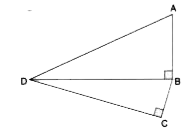The number of possible ∠ABC in which BC=√11cm,CA=√13cmandA=60∘ is
0
1
2
None of these
To solve the problem of finding the number of possible angles ∠ABC given BC=√11cm, CA=√13cm, and A=60∘, we will use the Sine Rule. Here’s a step-by-step solution:
Step 1: Write down the Sine Rule
The Sine Rule states that:
asinA=bsinB=csinC
Where a,b,c are the lengths of the sides opposite to angles A,B,C respectively.
Step 2: Identify the sides and angles
In our case:
- a=BC=√11
- b=CA=√13
- A=60∘
Step 3: Set up the Sine Rule for angle B
Using the Sine Rule, we can express sinB as follows:
√11sin60∘=√13sinB
Step 4: Substitute the value of sin60∘
We know that sin60∘=√32. Substituting this into the equation gives:
√11√32=√13sinB
Step 5: Cross-multiply to find sinB
Cross-multiplying gives:
√11⋅sinB=√13⋅√32
Thus,
sinB=√13⋅√32√11=√392√11
Step 6: Calculate the possible values for B
Now we need to find the angle B:
B=sin−1(√392√11)
Step 7: Consider the second possible angle
Since sinB can have two possible angles in the range 0∘ to 180∘:
1. B=sin−1(√392√11)
2. B=180∘−sin−1(√392√11)
Step 8: Conclusion
Thus, there are two possible values for ∠ABC. Therefore, the number of possible angles ∠ABC is 2.
The Sine Rule states that:
asinA=bsinB=csinC
Where a,b,c are the lengths of the sides opposite to angles A,B,C respectively.
In our case:
- a=BC=√11
- b=CA=√13
- A=60∘
Using the Sine Rule, we can express sinB as follows:
√11sin60∘=√13sinB
We know that sin60∘=√32. Substituting this into the equation gives:
√11√32=√13sinB
Cross-multiplying gives:
√11⋅sinB=√13⋅√32
Thus,
sinB=√13⋅√32√11=√392√11
Now we need to find the angle B:
B=sin−1(√392√11)
Since sinB can have two possible angles in the range 0∘ to 180∘:
1. B=sin−1(√392√11)
2. B=180∘−sin−1(√392√11)
Thus, there are two possible values for ∠ABC. Therefore, the number of possible angles ∠ABC is 2.
Topper's Solved these Questions
- PROPERTIES AND SOLUTION OF TRIANGLES BOOK - ARIHANT MATHS ENGLISHCHAPTER - PROPERTIES AND SOLUTION OF TRIANGLES EXERCISE - Exercise For Sesssion 3
34 Videos
- PROPERTIES AND SOLUTION OF TRIANGLES BOOK - ARIHANT MATHS ENGLISHCHAPTER - PROPERTIES AND SOLUTION OF TRIANGLES EXERCISE - Exercise For Sesssion 4
10 Videos
- PROPERTIES AND SOLUTION OF TRIANGLES BOOK - ARIHANT MATHS ENGLISHCHAPTER - PROPERTIES AND SOLUTION OF TRIANGLES EXERCISE - Exercise For Sesssion 1
20 Videos
- PRODUCT OF VECTORSBOOK - ARIHANT MATHS ENGLISHCHAPTER - PRODUCT OF VECTORSEXERCISE - Exercise (Questions Asked In Previous 13 Years Exam)
51 Videos
- SEQUENCES AND SERIESBOOK - ARIHANT MATHS ENGLISHCHAPTER - SEQUENCES AND SERIESEXERCISE - Exercise (Questions Asked In Previous 13 Years Exam)
38 Videos
Similar Questions
Using ruler and compasses only, construct a triangle ABC in which AB = 8 cm, BC = 6 cm and CA = 5 cm.
View SolutionThe given figure shows a quadrilateral ABCD in which AD =13 cm, DC= 12 cm, BC=3 cm and ∠ABC=∠BCD=90∘. Calculate the length of AB.

View SolutionConstructαΔABC in which AB=4.8cm,BC=5cmandCA=5.4cm.
View SolutionConstruct a triangle ABC with AB = 7 cm, BC = 3 cm, and CA = 5 cm.
View SolutionConstruet aΔABC in which AB=4cm,BC=4.6cmand∠B=75∘.
View SolutionConstruct a triangle ABC given that :
BC=6cm,CA=5.1cmand∠C=70∘
View SolutionConstruct a triangle ABC in which BC = 7cm, ∠B=75∘ and AB + AC = 13 cm.
View SolutionConstruct a triangle ABC in which BC=5cm,∠B=60∘and∠C=45∘.
View SolutionConstruct a triangle ABC given that :
AB = 5 cm, BC = 4 cm and CA = 6 cm
View SolutionConstruct a right angled ΔABC in which AB=4.2cm,BC=4.5cmand∠B=90∘.
View Solution
